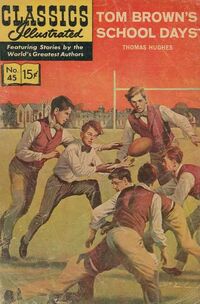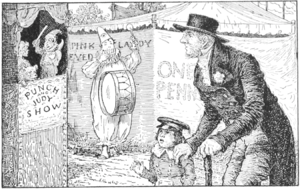
Issue #45 of Classics Illustrated contains an adaptation of Tom Brown's School Days.
Tom Brown's School Days (also published as Tom Brown's Schooldays) is a children's novel of eighteen chapters by the British author Thomas Hughes, who originally wrote it under the pseudonym "an Old Boy of Rugby". It was first published in 1857, although most of the action takes place some twenty years earlier. The novel was not primarily written as an entertainment but rather to prepare English boys for what they would encounter when they went away to boarding school and to present Hughes' ideas on boys' social and moral development.
The novel follows the life of its title character and protagonist, Tom Brown, from infancy to young manhood. Tom attends Rugby, a real public school[1] for boys in Warwickshire, England. He is intelligent but is more interested in sports and other physical activities than in studying.[2] The unwritten rules and traditions which all of the boys at Rugby follow are more important to Tom than the rules imposed by teachers, who Tom initially regards as his natural enemies. Although Tom cannot abide bullying (he suffers physical torment from the bully Flashman) and only fights to protect his friends, he becomes unruly and is frequently in trouble. In order to improve Tom's behavior, he is made to look after a younger and frailer boy named George Arthur. Tom helps Arthur to become stronger and more outgoing and, in return, Arthur shows Tom the value of honesty and hard work and teaches him not to be ashamed of his piety.
Thomas Hughes attended Rugby School between 1834 and 1842 and drew heavily on his experiences there in writing Tom Brown's School Days. The character of Tom Brown is a composite character, based on the author himself and his older brother George Hughes.
The novel has been adapted for the cinema three times, in 1916, 1940 and 1951, and adapted for British television twice, in 1971 and 2005. A musical based on the novel ran in London's West End in 1971.
Tom Brown's Schhool Days was enormously influential on later British "school stories" of the 19th and 20th centuries, including the Harry Potter series by J.K. Rowling. The British author George MacDonald Fraser used an adult version of the bully Flashman from Tom Brown's School Days as the central figure in a successful series of historical fiction novels.
Hughes wrote a sequel to the novel called Tom Brown at Oxford. Although Tom Brown's School Days remains popular after more than one hundred and fifty years, Tom Brown at Oxford has faded into obscurity.
Plot[]

As a very young boy, Tom Brown is taken to the village fair by an elderly male servant. 1911 illustration by Louis Rhead.
The novel begins by introducing the Brown family, who the author claims are an illustrious family, if not a very well known one, before shifting to describing the earliest years of Tom Brown's childhood in the Vale of White Horse, Berkshire,[3] Tom is the only child of the wealthiest and most powerful man in the village, as such, he has a privileged upbringing. As a small boy, he is mostly looked after by elderly male servants. He is educated at home by a tutor but enjoys playing with the boys from the local village school. The schoolmaster even agrees to allow a few of the boys to leave early each day, so that they can play with Tom.
At the age of twelve, in the early 1830s, Tom is sent away to an unnamed minor private school where he is not particularly happy. His time there comes to an abrupt end when there is an outbreak of fever and the school is closed. Tom's parents agree that he can start part way through the school year at Rugby. His father accompanies him for part of the journey but he makes the final phase of the trip, on the roof of a stage coach, by himself.
On arrival at Rugby, Tom is met by a boy named Harry East, also known by the nickname "Scud". The two quickly become good friends. On his first day at the school, Tom joins in an early version of the football game now known as rugby, in which there are dozens of players on each team.

Rugby School, the school which Tom Brown attends in the novel.
Tom quickly accepts all the traditions and rituals of the school, including the fact that he is expected to do chores for sixth formers. However, Tom refuses to do chores for the fifth former Flashman and his gang of followers. Flashman's bullying of Tom and other younger boys becomes steadily worse. When Tom refuses to give Flashman a sweepstake ticket for the favorite in an upcoming horse race, Flashman and his followers hold Tom up to a fireplace so that he is deliberately burned. Although Tom refuses to say anything to any members of school staff about how he got his injuries, Flashman is expelled soon afterwards when he is found drunk on hard liquor.[4] With Flashman gone, his former followers gradually give up their bullying ways and life at the school improves for all students.
The behavior of Tom Brown and Harry East gets steadily worse. They carve their names wherever they can. They even climb onto a roof in order to carve their names on the hands of the school's clock, causing the clock to go slow afterwards. The headmaster, Thomas Arnold,[5], known as "the Doctor", decides that the best way to improve Tom's behavior is to put him in charge of a younger student.

Tom Brown, Arthur and East study the Bible. 1911 illustration by Louis Rhead.
At the start of the next term, the matron asks Tom to help settle in a new boy called George Arthur. Arthur's father had been a clergyman who had died young. Arthur himself is not very strong and is very pious. Other boys laugh at Arthur when he says his prayers before going to bed. However, Tom thinks him brave for doing so. He quickly begins to follow Arthur's example and also prays before going to sleep. Other boys gradually follow Tom's example also. Tom and Arthur begin to regularly read and discuss the Bible together. Harry East later joins in their Bible classes too. With the help of Tom and East, Arthur makes more friends, learns to fish and swim and enjoy the outdoors.
When another boy makes fun of Arthur for being moved to tears by a passage from Homer, Tom fights him. When Arthur nearly dies of a fever, Tom promises to put more effort into his school work. For years, when doing translations from Latin and Greek, Tom had relied on "crib books' written by earlier generations of Rugby students, effectively copying what another student had written and not thinking about the meaning of the original text at all. Having promised Arthur to give up the "crib books", even though he finds it very difficult to translate without them, Tom later succeeds in persuading East and his other friends to give them up as well.
The penultimate chapter takes place on Tom's last day at Rugby. Tom has become the captain of the cricket team and Arthur is one of his players. Tom's team play against a team of older men from London. The Rugby School team loses but Tom is proud of how both he and Arthur have developed. Tom is surprised when a teacher tells him that his friendship with Arthur had been engineeered by "the Doctor" in order to improve his behavior.
The final chapter takes place in 1845. Tom, now a university student, is on vacation with some friends in Scotland when he hears of the death of "the Doctor". Tom immediately goes back to Rugby in order to pay respect to the man who had such a great influence on his life.
Footnotes[]
- ↑ In England, "public school" refers to what would be called a "private school" in most other English-speaking countries. What is called a "public school' in most other English-speaking countries is called a "state school" in England.
- ↑ The only school subjects which are referred to in Tom Brown's School Days are Latin and Greek. The emphasis in the novel is on character development, rather than on academic success.
- ↑ English county boundaries have been redrawn since Tom Brown's School Days was written. The Vale of White Horse is now in Oxfordshire, not Berkshire.
- ↑ Although possession of hard liquor is forbidden at the school in Tom Brown's School Days, beer is seen as harmless by students and staff alike. Even the youngest boys are provided with bottled beer with their school meals and are allowed twice as much beer on Saturdays.
- ↑ Thomas Arnold (1795-1842) was a genuine historical figure who was headmaster of Rugby School between 1828 and 1841.
